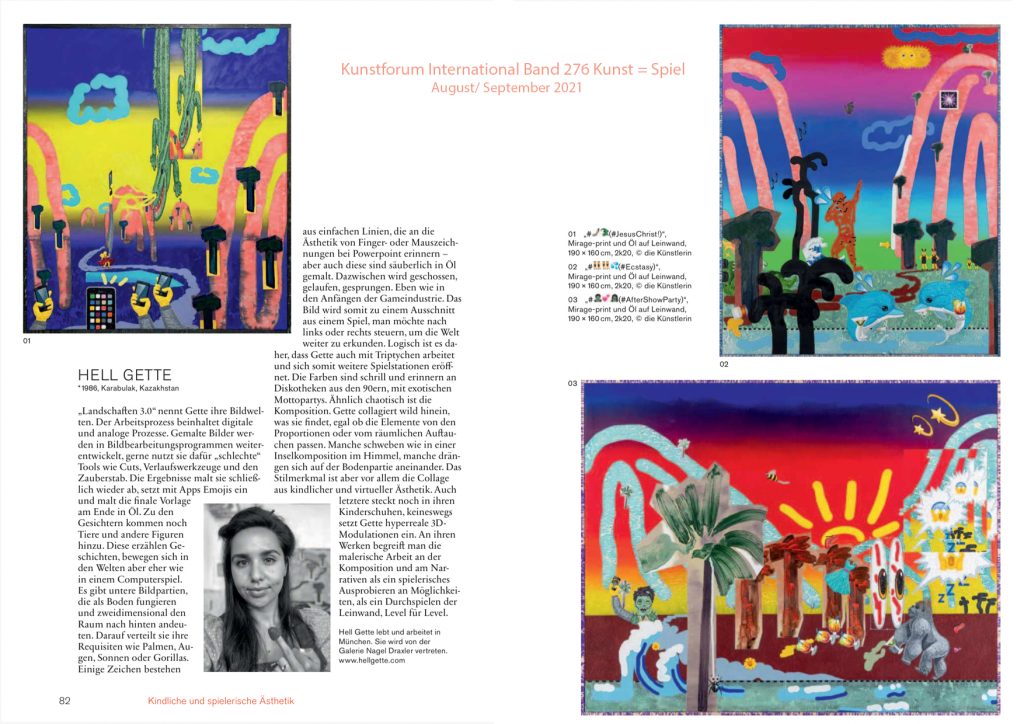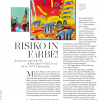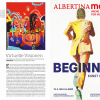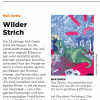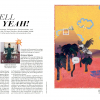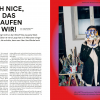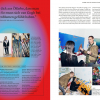Hell Gette “CyScapes”
In Svetlana Boym’s 2001 book, The Future of Nostalgia, nostalgia is defined as “a longing for a home that no longer exists or has never existed.” Boym recognized nostalgia as particularly acute for those in exile: “At once homesick and sick of home, they developed a peculiar kind of diasporic intimacy, a survivalist aesthetics of estrangement and longing.” Although nostalgia is a modern term coined in the 17th century (derived from nóstos, meaning „homecoming“, a Homeric word, and álgos, meaning „pain“), the concept was a common theme of ancient literature, the archetypal example being Homer’s The Odyssey. Perhaps it is fitting then that Hell Gette, a painter who fled Kazakhstan with her family for Germany as a child, has chosen Homer’s epic poem of Odyssesus’ nostos, as the framework for her latest series of paintings.
Over the years, Gette has developed a genre she describes as “Landscape 3.0” through a process of transforming traditional landscape studies made en plein air into digital pastiches that pull from old school video games, photoshop tools, and emoji icons; throwback imagery emblematic of Gette’s Millennial Generation. The work is manipulated in layers, through both analog and digital techniques, until the discordant elements coalesce as virtuosic oil paintings. Impasto emojis are applied to the surface of the canvas last, like 3D stickers, adding both dimension and disorder. In Gette’s newest series, titled “CyScapes,” conceived and executed during a year abroad in the United States, the viewer is transported into a first-person video game loosely based on The Odyssey. From the POV of a genderless Odysseus, Gette invites us to become the protagonist of one of the greatest stories of Greek mythology.
Our journey begins with #👁🧟(#OM / #Polyphem3.0 ) as the game starts to upload. Gradient mountains and Super Mario clouds surround a zombie emoji with a glowing third eye, Gette’s take on the cyclops Polyphemus. Rough photoshop smudges of burgundy surround the figure and reappear in #👋 🧞♀️ (#Calypso3.0) as a path leading up to a tiny genie emoji. The scene depicts our exodus from the goddess Calypso, who had been holding Odysseus captive as her lover for seven years. Emoji hands, thickly painted, wave goodbye. In #🌞 🗡 (#sunstorms #sirenes3.0) we are fully immersed in the game from a first-person shooter perspective, with burning swords in the foreground to safeguard the viewer/player. The genie emoji is repurposed to represent the sirens, hovering above a mountain range that is rendered in a faux-watercolor to imitate Gette’s original landscape studies. Multiple smeared suns hover in the sky like blazing ghosts. In #🤳 (#Yolo #MénageÀTrois), the jewel-toned sirens appear again on the screens of smartphones held up by disembodied yellow arms (the default emoji skin tone) capturing selfies of what the title suggests is a scene of polyamory. The perspective shifts in #🧞♀️ 🧟 (#MortalKombat), a horizontal double-panel painting that adapts the two-player fighter format of the popular 90s arcade-turned-console game, Mortal Kombat. In the battle between Calypso and Polyhemus, Calypso is in the lead, indicated by the green lifelines on the top edges of the canvas. But with the burning swords in the frame again, the viewer becomes a potential third opponent in a battle royale, another sort of ménage à trois.
According to Svetlanna Boym, “The nostalgic feels stifled within the conventional confines of time and space.” With references that span 7000 years, Gette has produced a transhistorical game-as-painting that explores the violence, fantasy, and melancholy of displacement. And she’s made it fun.
– Julia Trotta
CAPRICCI OF THE 21. CENTURY
THE LANDSCAPES BY HELL GETTE
An explicitly artificial spin-off in the art of the Baroque Age, is the so-called “Capriccio”. The origin of the term is uncertain, however, etymological research suspects a composition of the Italian words “capo” (head) and “riccio” (hedgehog), literally meaning “hedgehog-head” or rather “scatterbrain”. These paintings rarely show mere landscape areas, but much rather places for a free gathering of figures and objects. Typical for the Capriccio was the deliberate blurring of conventions of pictorial genres, which were otherwise hierarchically separated from each other (history/tale, portrait, genre, landscape, still life – in exactly this order). Artists thus playfully redefined rules and boundaries and consequently made bold use of freedoms, which in retrospect can be seen as the first foundation of anti-academic Modernism.
With that being said, it is appealing to consider Hell Gette’s landscapes as Capricci of the 21st century. The contemporary aspect lies in the fact, that her works integrate the conflict between the analogue and the digital world playfully into the work process – “conflict” implicating not a critical, rather the original neutral meaning of the word “conflict”, suggesting an “impact”. This happens when the artist combines her findings on the internet and the connected digital tools – with the hand-drawn, the photographs taken with the mobile phone, the experimental prints or graphically (sometimes not so well) designed, bringing it all back to the traditional oil painting, thus reflecting a highly contemporary concept of painting and treating all media equally.
At the same time, Hell Gette’s paintings emphasize how strongly our experiences today are not only influenced by pictorial templates (of the arts, the movies, television, advertisement, social media, etc). Moreover, they show that even our feelings can be expressed by patterns or icons, letting the body go through a subtle estrangement from an immediate perception, providing that such a perception, in its pure form has ever existed. However, Hell Gette articulates this in her paintings rather as an observation than criticism.
Quote from Prof.Dr.Bernhart Schwenk: Capricci of the 21.Cenutury,
The Landscapes by Hell Gette, in: Hell Gette: #Landscape3.0,
Sponsored by: Bavarian Ministry for Education and Culture, Science and Art; LfA Förderbank Bavaria
CAPRICCI DES 21. JAHRHUNDERTS
DIE LANDSCHAFTEN VON HELL GETTE
Ein explizit artifizieller Ableger in der Kunst des Barockzeitalters war das sogenannte „Capriccio“. Die Herkunft dieser Bezeichnung ist unklar, doch vermutet die etymologische Forschung, dass sie aus der Zusammensetzung der italienischen Wörter „capo“ (Kopf) und „riccio“ (Igel) entstanden ist und demnach wörtlich mit „Igelkopf“ oder „Wirrkopf“ übersetzt werden könnte. Bei den Bildern handelt es sich meist nicht um reine Landschaftsräume, sondern um Orte für eine freie Ansammlung von Figuren und Gegenständen. Typisch für das Capriccio war, dass es die Konventionen der sonst hierarchisch voneinander getrennten Bildgattungen (Historie, Porträt, Genre, Landschaft, Stilleben – in genau dieser Reihenfolge) bewusst verwischte, dass die Künstler mit dem Capriccio Regeln und Grenzen spielerisch neu definierten und somit kühn Freiheiten für sich in Anspruch nahmen, die im Rückblick als ein erstes Fundament der antiakademisch agierenden Moderne angesehen werden dürfen.
Vor diesem Hintergrund ist es reizvoll, die Landschaften von Hell Gette als Capricci des 21. Jahrhunderts zu betrachten.
Das Zeitgenössische liegt dabei vor allem darin, dass die Arbeiten den Konflikt – nicht in einem kritischen, sondern im ursprünglich neutralen Sinn des Worts „Konflikt“ als „Zusammenprall“ – der analogen mit der digitalen Welt spielerisch in den Werkprozess einbinden. Dies geschieht, indem die Künstlerin das im Internet Gefundene samt aller digitalen Tools, das mit der Hand Gezeichnete, das mit dem Handy Fotografierte, das experimentell Gedruckte oder grafisch (manchmal auch weniger gut) Gestaltete an die traditionelle Ölmalerei rückbindet – und so einen höchst aktuellen Bildbegriff widerspiegelt, der alle Medien als gleichberechtigt ansieht.
Gleichzeitig machen die Bilder von Hell Gette deutlich, wie stark unsere Erfahrungen heute nicht nur von Bildvorlagen (der Kunst, des Kinos, des Fernsehens, der Werbung, der sozialen Medien etc.) geprägt sind. Darüber hinaus zeigen sie, dass auch unsere Gefühle durch Vorbilder oder eben Bildzeichen Ausdruck finden, dass also insgesamt eine schleichende Entfremdung des Körpers von einer unmittelbaren Empfindung stattfindet – vorausgesetzt, dass es eine solche Empfindung in Reinform je gegeben hat. Aber auch dies artikuliert Hell Gette in ihren Bildern eher als Beobachtung denn als Kritik.
Zitat aus: Bernhart Schwenk: Capricci des 21. Jahrhunderts,
Die Landschaften von Hell Gette, in: Hell Gette: #Landschaft 3.0;
Finanziert durch: Bayrisches Ministerium für Bildung und Kultus, Wissenschaft und Kunst; LfA Förderbank Bayern
Press (selected)
„Kunstforum International“, Band 276, Larissa Kikol
Selected press:
Interview @ Artfridge with Juergen Dehm, Jan 2020:
